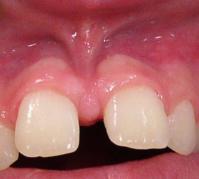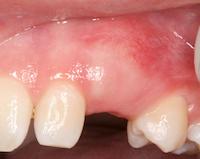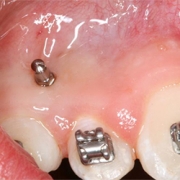Assessment for the presence of any gum disease before orthodontic treatment is wise to ensure that orthodontic treatment is done in a non-infected oral environment
Your Specialist Orthodontist may require certain minor procedures to be done as part of your orthodontic treatment. These procedures are usually advised and determined by your Specialist Orthodontist.
Some of these procedures include the following:
Frenectomy

A frenum is a naturally occurring ligament that holds and sometimes restricts the movement of tissues such as the lip, cheek or tongue in the mouth. There are, however, situations where this ligament extends too far onto the gum and may prevent the teeth aligning properly and therefore leaving a gap.


A frenectomy is a minor procedure whereby these ligaments are removed. A cut is made to remove the ligament under local anaesthesia. Stitches are usually required for wound closure.
The timing of when to perform the procedure may vary from patient to patient. In order to enhance the success of the result, it is important to have this assessed prior to considering this treatment.
Pericision
 In normal anatomy, tissue fibres (called gingival fibres) attach to the root surfaces, serving to support the teeth as well as the surrounding gum tissues.
In normal anatomy, tissue fibres (called gingival fibres) attach to the root surfaces, serving to support the teeth as well as the surrounding gum tissues.
Following orthodontic treatment, teeth which used to be out of alignment or rotated have ligaments that are often twisted and become in tension.
The release of these ligaments from the tooth surface using a simple incision (under local anaesthetics) allows them to re-attach in a new non tense position improving the post-orthodontic stability of realigned teeth.
Exposure of Unerupted Teeth
 During the replacement from baby teeth to adult teeth, there are cases where new adult teeth do not erupt along their normal path of eruption.
During the replacement from baby teeth to adult teeth, there are cases where new adult teeth do not erupt along their normal path of eruption.
This often causes a delay in the eruption of the new tooth, which can also lead to the mal-positioning of this new tooth or even adjacent teeth.
These obstructions in eruption of the new tooth may be due to crowded adjacent teeth, thick overlying gum or abnormally thick overlying bone structures.
Surgical exposure can be done on such a tooth, to create a window opening where an orthodontic bracket can be placed onto the surgically exposed buried surface of the tooth.
Allowing the placement of the orthodontic bracket will enable the orthodontist to gently manoeuvre the unerupted tooth into a path which allows good final tooth alignment. The exposure procedure is done under local anaesthesia.
Patients are generally advised to stay well rested, and avoid contact sports and swimming activities for at least 2 weeks after the procedure.
Placement of Mini-implants
 Mini-implants (mini-screws) can be placed under local anaesthesia to provide additional anchor points for orthodontic tooth movement.
Mini-implants (mini-screws) can be placed under local anaesthesia to provide additional anchor points for orthodontic tooth movement.
This is done under the specific need and prescription from the orthodontist. These mini-implants will require removal once their use is no longer needed.
